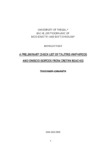| dc.creator | Zarkogiannis S.D., Kontakiotis G., Vousdoukas M.I., Velegrakis A.F., Collins M.B., Antonarakou A. | en |
| dc.date.accessioned | 2023-01-31T11:38:18Z | |
| dc.date.available | 2023-01-31T11:38:18Z | |
| dc.date.issued | 2018 | |
| dc.identifier | 10.1016/j.coastaleng.2017.12.003 | |
| dc.identifier.issn | 03783839 | |
| dc.identifier.uri | http://hdl.handle.net/11615/80956 | |
| dc.description.abstract | Beach cliffing is a wide-spread characteristic of artificially-replenished beaches, which has many undesirable engineering, environmental and economic consequences. A sedimentological study undertaken on the replenished mixed gravel and sand beach of Hayling Island (southern England) has shown that the persisting beach cliff consists typically of three distinct layers. The textural, geochemical and mineralogical analyses of the deposit showed that the development of the cliff, and particularly the formation of the intermediate, densely-packed layer, could be attributed to a series of processes. Firstly, the techniques used to emplace the recharge material on the beach (i.e. placement by heavy dumper trucks/bulldozers) result in a compaction and grain-fracture of the recharge material, and therefore a denser packing arrangement than that expected by its textural characteristics alone. Secondly, percolating water transfers medium- and fine-grained material to deeper parts of the deposit, resulting in the clogging of the interstices between the gravels and the formation of a densely-packed, poorly-sorted layer. The above processes promote the interactions between the clay minerals of the deposit with [Ca2+] cations, resulting in the formation of particular cementing materials, such as Calcium Silicate Hydrates (CSH). © 2017 Elsevier B.V. | en |
| dc.language.iso | en | en |
| dc.source | Coastal Engineering | en |
| dc.source.uri | https://www.scopus.com/inward/record.uri?eid=2-s2.0-85037809812&doi=10.1016%2fj.coastaleng.2017.12.003&partnerID=40&md5=3a74e2bed28546d8921e01670a20fcaa | |
| dc.subject | Calcium | en |
| dc.subject | Calcium silicate | en |
| dc.subject | Clay deposits | en |
| dc.subject | Clay minerals | en |
| dc.subject | Deposits | en |
| dc.subject | Gravel | en |
| dc.subject | Hydrates | en |
| dc.subject | Hydration | en |
| dc.subject | Mining laws and regulations | en |
| dc.subject | Silicates | en |
| dc.subject | Stucco | en |
| dc.subject | Calcium silicate hydrate | en |
| dc.subject | Cementing material | en |
| dc.subject | Coastal erosion | en |
| dc.subject | Economic consequences | en |
| dc.subject | Fine-grained material | en |
| dc.subject | Gravel beaches | en |
| dc.subject | Mineralogical analysis | en |
| dc.subject | Textural characteristic | en |
| dc.subject | Beaches | en |
| dc.subject | beach | en |
| dc.subject | clay mineral | en |
| dc.subject | cliff | en |
| dc.subject | coastal erosion | en |
| dc.subject | emplacement | en |
| dc.subject | morphodynamics | en |
| dc.subject | sand and gravel | en |
| dc.subject | sedimentology | en |
| dc.subject | X-ray diffraction | en |
| dc.subject | England | en |
| dc.subject | United Kingdom | en |
| dc.subject | Elsevier B.V. | en |
| dc.title | Scarping of artificially-nourished mixed sand and gravel beaches: Sedimentological characteristics of Hayling Island beach, Southern England | en |
| dc.type | journalArticle | en |

